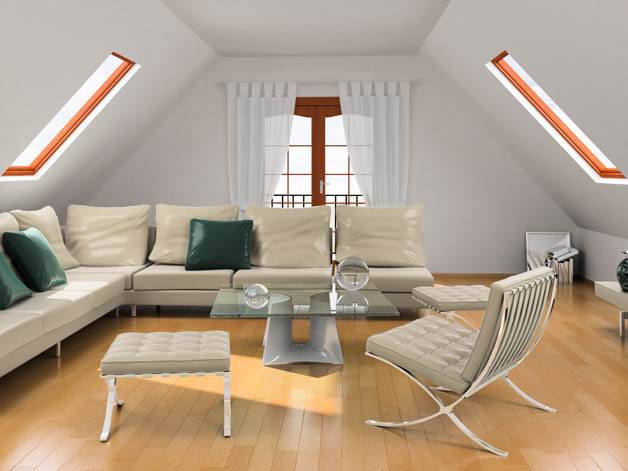 Anyone who only stores junk under the roof or does not use the extension reserve in the new house, gives away valuable living space. No matter if single or family, precisely planned and carefully thought out, you create space for children in every attic, Guests, To work.
Anyone who only stores junk under the roof or does not use the extension reserve in the new house, gives away valuable living space. No matter if single or family, precisely planned and carefully thought out, you create space for children in every attic, Guests, To work.
It's definitely the biggest project, that a do-it-yourselfer dares to do, but a loft conversion is worthwhile and offers an incredible number of possibilities, to lend a hand. This is how you get a lot of new living at affordable costs- and storage space. In the case of the widespread new construction of a single-family house with approx 80 square meters of floor space, in addition to a spacious bathroom, there is also space for a bedroom and up to two children's rooms (2).
When you stand in the empty attic space, the available space appears, to be huge. But through thrashing (Kniestock), Walls and a necessary corridor area quickly turn into relatively small areas from the large area. Careful consideration of your own ideas and precise planning are prerequisites for the perfect living space under the roof. The afet bath under the roof is a good idea, because there is simply more space available. Who only has one child to accommodate, will be able to treat themselves to a spacious bedroom (1). Of course, couples and singles are a bit more variable here.
You have enough space, to set up a study or guest room (4). One can also, except for the bath, do without walls and divide the room into different areas with appropriate furnishings (3). In any case arises from asides, Storerooms and built-in closets provide plenty of storage space. But there are many things to consider.
If your roof offers you enough headroom (see box page 19), you have to clarify first, whether you get enough light under the roof. The glass surfaces of the windows must correspond to at least one eighth of the floor area (All areas count as the base area 1,5 m ceiling height). According to building law, your roof is only considered living space if it is sufficiently exposed. Up to here you can clarify the requirements yourself, but what is permissible and what requires approval, only the building authority or an architect can tell you. This is because building law in the individual federal states often differs considerably.
Before that, however, your planning should be completed and all important expansion projects should be clarified:
INSULATION
No matter, whether you use conventional glass or mineral fibers or ecological insulating materials for the roof insulation, all materials are easy to process. Such are ideal, which you simply between the rafters or, for under-rafter insulation, clamp a counter batten. In any case, you improve the energy balance of your house.
WALLS
Brick walls have no place in self-construction. they are heavy (Static!) and difficult to process. It is easier with large-format aerated concrete blocks, which are simply glued together.
However, lightweight walls made of plasterboard on a substructure made of metal profiles are ideal, which, if needed, easy to change later. In addition, you can, depending on the construction of the wall structure, the sound- and optimize fire protection. And there is no need for complicated plastering either!
HEATING
Anyone who had not previously planned to expand their attic, must reckon with it, that the heating system needs to be upgraded. Have an installer check it out, whether your heating can cope with additional radiators and, if necessary, also water extraction points. All the necessary work should be done by a professional. This is the only way you have the full guarantee, if something doesn't work. After all, heating damage can quickly lead to costly water damage. exceptions are, in consultation with the installer, the self-assembly of the radiators and bathroom fittings.
WINDOW
To get enough light under the roof, there are three options: gable window, Dormers and skylights. While the subsequent installation of the first two options must be done by a professional, you can now easily install roof windows yourself thanks to well-engineered mounting systems. Provided, You don't have to make any changes to the roof structure. Here the carpenter is asked first.
FLOOR
The floor under the roof is usually of a simple design and even in new buildings you only see the raw concrete. It applies here, create a level surface for the final floor covering. At the same time, sound bridges and room sound transmission must be prevented. Here, too, floor elements made of modern plasterboard have the Na- “** se in front. These so-called dry screed elements are handy and can be laid without prior knowledge. An edge insulation strip prevents the transmission of impact sound to the walls and thus to neighboring rooms. An insulating material lamination on the underside of the element provides heat when required- and for impact sound insulation. If the subfloor is very uneven, becomes a leveling fill before laying, for example from gypsum granules, inserted and removed horizontally. Electrical cables and, if the layer is sufficiently thick, water pipes can be elegantly hidden in the fill.
INSTALLATION
Do-it-yourselfers should stay away from three areas: Gas, water- and electrical installations! You can lay drains and pull electrical cables yourself, but you should coordinate the planning of the installations with a professional. Pressurized water lines are the responsibility of the installer, to rule out expensive water damage in advance. Electrical installations may only be connected by certified electricians. It stands for the safety and functionality of your power supply.